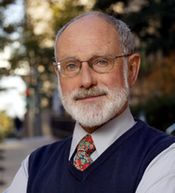Ronald H. Gray

|
| Ronald H. Gray |
| Verheiratet mit: |
| Maria Wawer |
| Kollegen & Förderer: |
| Maria Wawer Robert C. Bailey Bertran Auvert Brian J. Morris Aaron Tobian Thomas Quinn |
| Gefördert durch: |
| Bill & Melinda Gates Foundation Johns Hopkins National Institutes of Health |
 Ronald Gray mit seiner Ehefrau und Kollegin, Maria Wawer. |
Ronald H. Gray ist ein nordamerikanischer Befürworter der Beschneidung und ein voreingenommener Forscher, der nach Rechtfertigungen für die Einführung von Massenbeschneidungsprogrammen auf der ganzen Welt sucht. Er leitete eine der drei RCTs (Randomisierte kontrollierte Studien), die von der WHO verwendet wurden, um die Beschneidung als HIV-Prävention zu unterstützen.[1] In ihrer Klinik wird kontinuierlich ein Musikvideo abgespielt, das für Beschneidung wirbt.[2][3] Er wird manchmal Ron genannt.[4]
Ronald Grays RCT
Bei den drei RCTs, die von der WHO benutzt wurden, um Beschneidung als HIV-Präventio zu bewerben, beaufsichtigte Gray die randomisierte kontrollierte Studie, die in Uganda durchgeführt wurde.[5] Zwei andere RCTs wurden überwacht von Robert C. Bailey beziehungsweise von Bertran Auvert. Alle drei RCTs wurden von den amerikanischen National Institutes of Health finanziert.[6]
Im Jahr 2010[7] und auch wieder 2011[4] veröffentlichte Gray Studien mit Brian J. Morris.
Zitate
| ” | We've never used surgery to prevent an infectious disease. It's a completely new concept, a new paradigm. How can we train all the surgeons to do this procedure and equip them. – Ronald H. Gray (JohnsHopkinsSPH)[8] |
| ” | It's been hard to change policy, because this is a whole new paradigm. We've never used surgery to prevent an infectious disease. Policy makers have to really take some time to wrap their minds around it. – Ronald H. Gray (JohnsHopkinsSPH)[9] |
| ” | It's taken longer than I would like to see these programs emerge. – Ronald H. Gray (JohnsHopkinsSPH)[10] |
| ” | The Latest Fight Over Foreskin If you were to ask me, should the U.S. be promoting circumcision, my answer would be, ‘no,’ What I do think ought to be the policy is that parents should be informed about the potential protective effects. – Ronald H. Gray (N.Y. Times)[11] |
Einzelnachweise
- ↑
 Weltgesundheitsorganisation.
Weltgesundheitsorganisation. Information Package on Male Circumcision and HIV Prevention
. Abgerufen 7. Mai 2011. - ↑
 JohnsHopkinsSPH (1. Oktober 2010).
JohnsHopkinsSPH (1. Oktober 2010). Rakai Project
. Abgerufen 10. April 2011. - ↑
 smugamba (6. Juni 2010).
smugamba (6. Juni 2010). Rakai Male Circumcision Video By Stephen Mugamba Feat Jemima Sanyu.mpg
. Abgerufen 10. April 2011. - ↑ a b
 Morris, Brian J., Gray, Ronald H., Castellsagué, Xavier, Bosch, F. Xavier, Halperin, Daniel T., Hankins, C.A., Waskett, Jake H.. The Strong Protective Effect of Circumcision Against Cancer of the Penis. Advanced in Urology. 9. März 2011; Abgerufen am 13. März 2011.
Morris, Brian J., Gray, Ronald H., Castellsagué, Xavier, Bosch, F. Xavier, Halperin, Daniel T., Hankins, C.A., Waskett, Jake H.. The Strong Protective Effect of Circumcision Against Cancer of the Penis. Advanced in Urology. 9. März 2011; Abgerufen am 13. März 2011.
- ↑
 Gray, R.H., Kigozi, G., Serwadda, D., et al. Male circumcision for HIV prevention in men in Rakai, Uganda: a randomised trial. Lancet. 369: 557-566.
Gray, R.H., Kigozi, G., Serwadda, D., et al. Male circumcision for HIV prevention in men in Rakai, Uganda: a randomised trial. Lancet. 369: 557-566.
- ↑
 (2008).
(2008). The Use of Male Circumcision to Prevent HIV Infection
, Doctors Opposing Circumcision. Abgerufen 5. März 2011.
Zitat:...funding from the United States National Institutes of Health to conduct randomized controlled trials (RCTs) in Africa.
- ↑
 Gray, R.H., Bailey, R.C., Morris, B.J.. Keratinization of the adult male foreskin and implications for male circumcision. AIDS. 1. Juni 2010; 24(9): 1381; author reply 1381–2. PMID. DOI.
Gray, R.H., Bailey, R.C., Morris, B.J.. Keratinization of the adult male foreskin and implications for male circumcision. AIDS. 1. Juni 2010; 24(9): 1381; author reply 1381–2. PMID. DOI.
- ↑ JohnsHopkinsSPH, (2009). Impact.
- ↑ JohnsHopkinsSPH, (2010). Rakai project.
- ↑ JohnsHopkinsSPH, (2010). Rakai project.
- ↑ N.Y. Times, The Latest Fight Over Foreskin, (8/29/2009).